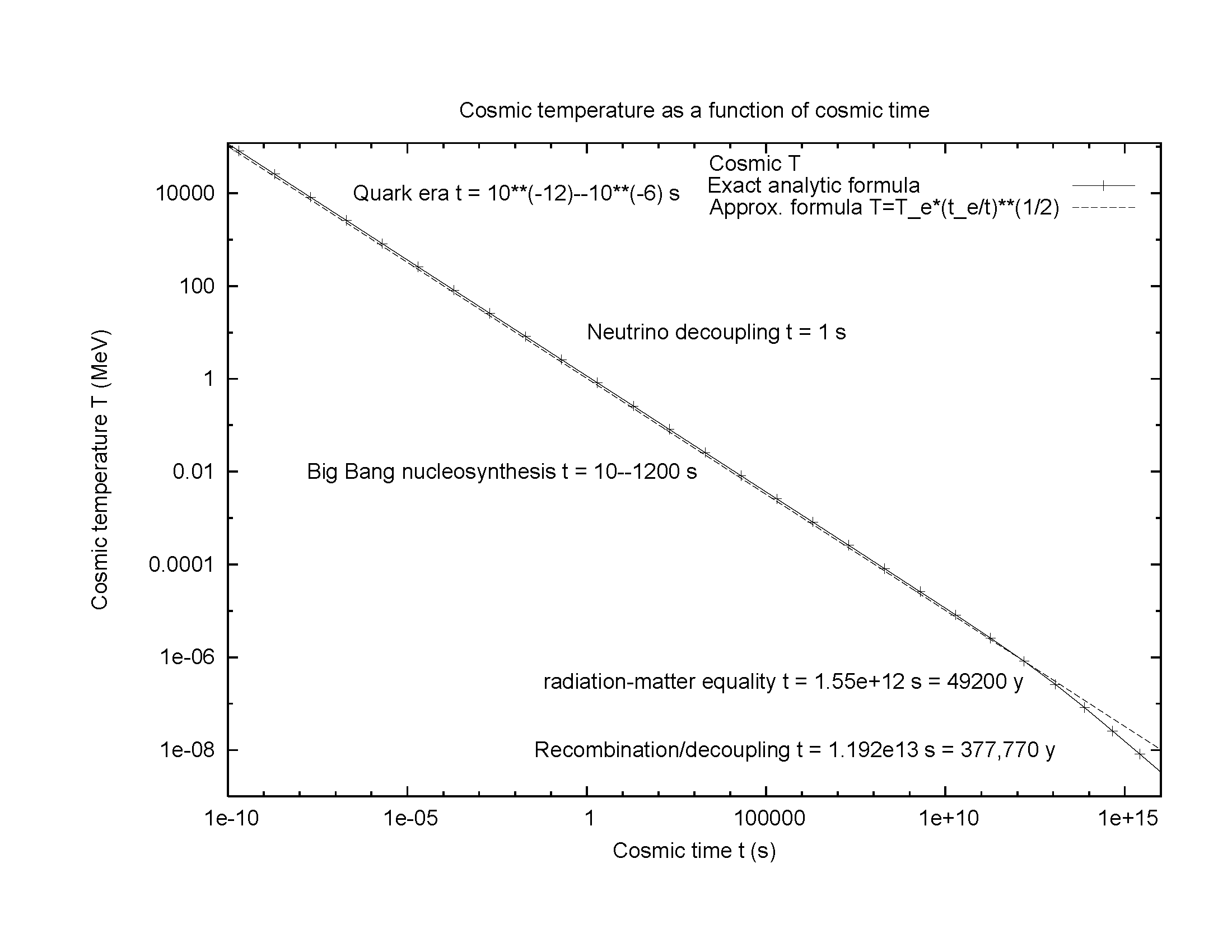
Caption: A log-log plot of cosmic temperature (in mega-electron-volts (MeV): 1 MeV ≅ 10**10 K) versus cosmic time 10**(-10) s -- 10**16 s ≅ 0.3 Gyr.
Features:
- Note, the
Boltzmann contant
k = 1.380649*10**(-23) J/K = (0.8617333262 ...)*10**(-4) eV/K (exact) ≅ 10**(-4) eV/K
= 10**(-10) Mev/K
(see NIST:
Fundamental Physical Constants).
Thus, 1 mega-electron-volt (MeV)
corresponds to about 10**(10) K.
- The
cosmic temperature
at all cosmic times
later than the quark era (10**(-12) -- 10**(-6) s)
at least is the temperature
of cosmic background radiation (CBR).
The cosmic temperature
is, in fact, the only
temperature
in the observable universe
(other than that of the dark matter)
until
recombination era t = 377,770(3200) y
during which occurs
decoupling era
when
CBR
baryonic matter
decoupled and ceased to have the same
temperature.
- The present cosmic time
CBR is mainly
in the
microwave band (fiducial range 0.1--100 cm, 0.01--10 cm**(-1))
and is the
cosmic microwave background (CMB)
with
CMB T = 2.72548(57) K (Fixsen 2009)
(see also
Wikipedia:
Cosmic microwave background radiation: Features).
- The cosmic temperature
obeys a very simple relation:
T = T_0*(a_0/a) = T_fiducial*(a_fiducial/a) or T ∝ 1/a ,
where subscript 0 indicates present cosmic time, a_0 = 1 conventionally, and subscript fiducial indicates any fiducial cosmic time. Since there is the universal expansion, cosmic temperature falls with cosmic time. - For cosmic time less than the
radiation-matter equality 49200 y = 1.55*10**12 s
a ∝ t**(1/2) and after a ∼ ∝ t**(2/3).
Thus,
T ∝ t**(-1/2) before radiation-matter equality; T ∝ ∼ t**(-2/3) after radiation-matter equality.
Recall on log-log plots, the exponent (AKA power) becomes the slope. Hence, the slope of the cosmic temperature is -1/2 before the radiation-matter equality and about -2/3 after.
- Cosmic history eras
(all times are approximate):
- very early universe (t < 10**(-12) s)
- early universe (10**(-12) s -- 377.770(3200) kyr)
- dark ages and large-scale structure emergence era (377.770(3200) kyr -- 1 Gyr)
- cosmic noon (cosmic time t ∼ 3.5 Gyr, z ∼ 1.9): This is the peak of the cosmic star formation rate (SFR).
- cosmic present t_0 = to the age of the observable universe = 13.797(23) Gyr (Planck 2018)
Local file: local link: cosmic_temperature.html.
File: Cosmology file: cosmic_temperature.html.